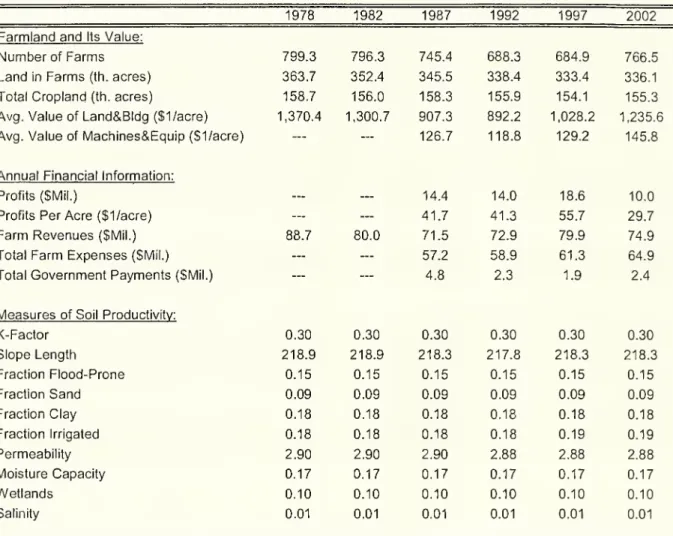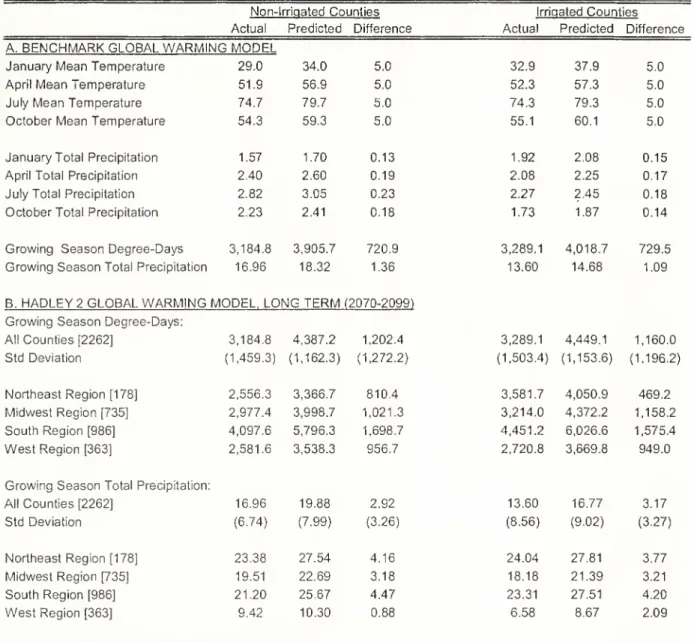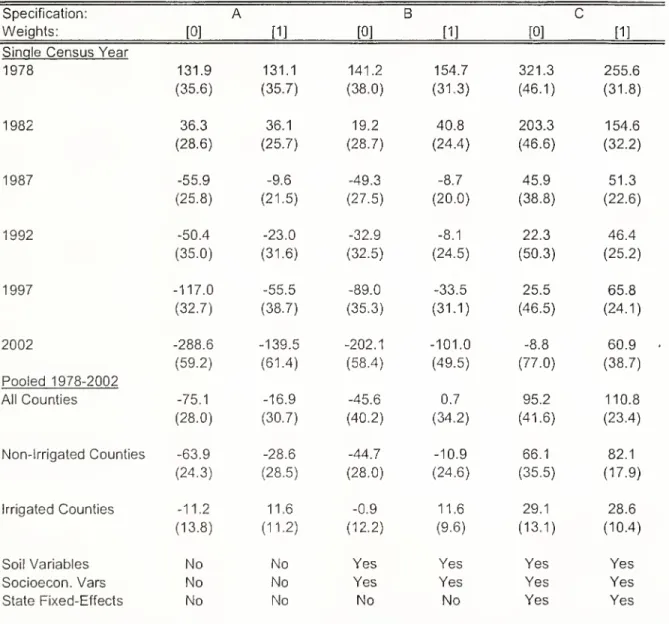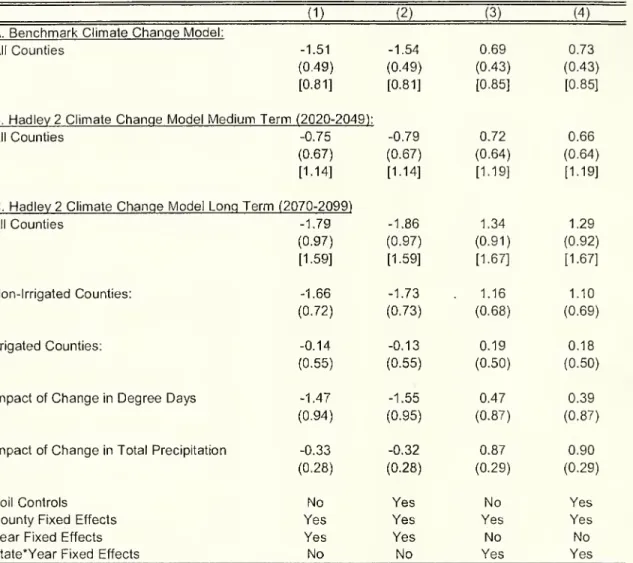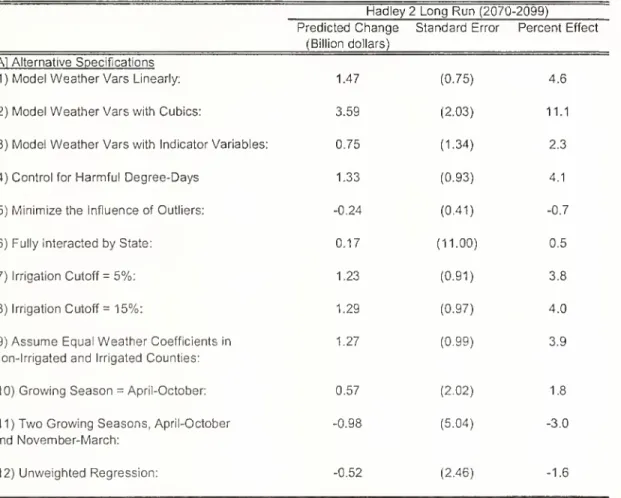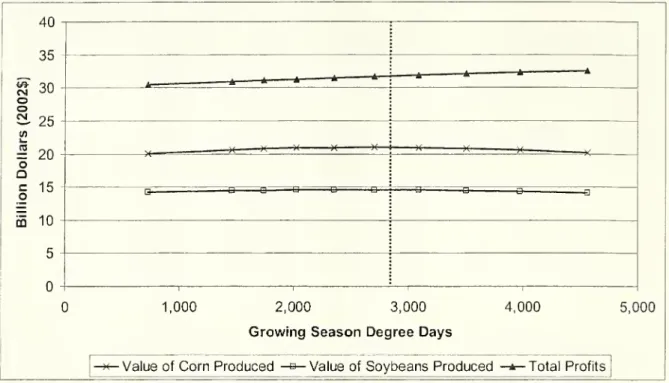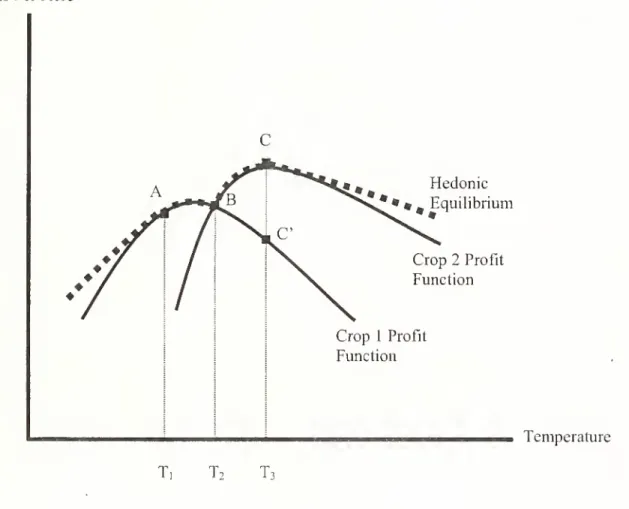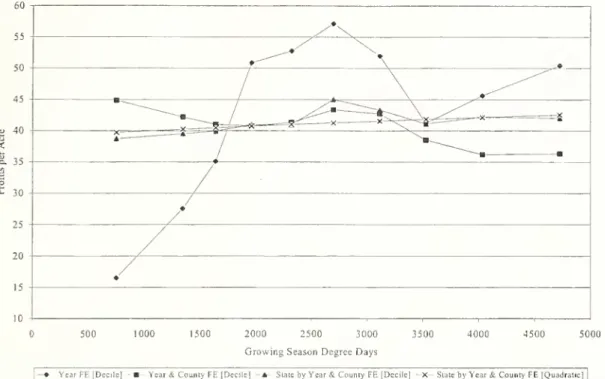II I
III
1 1 II II I 1 13
9080
02617 9306
W: , iwiiiM\'-wx\\y,HB31
.M415
no.
04-26
2006b
li
If"
Digitized
by
the
Internet
Archive
in
2011
with
funding
from
Boston
Library
Consortium
Member
Libraries
,
UfcWt
HB31
.M415
Ac.04-Massachusetts
Institute
of
Technology
Department
of
Economics
Working
Paper
Series
The
Economic
Impacts
of
Climate
Change:
Evidence
from
Agricultural
Profits
and
Random
Fluctuations
in
Weather
Olivier
Deschenes
Michael
Greenstone
Working
Paper
04-26
July
2004
Revised:
January
2006
Revised:
August
2006
Room
E52-251
50
Memorial
Drive
Cambridge,
MA
02142
This
paper
can
be
downloaded
without
charge from
the SocialScience
Research
Network
Paper
Collection atMASSACHUSETTS
INSTITUTEOF
TECHNOLOGY
The
Economic
Impacts
ofClimate
Change:
Evidence
from
Agricultural
Profitsand
Random
Fluctuations
inWeather*
Olivier
Deschenes
University
of
California,Santa
Barbara
Michael
Greenstone
MIT
and
NBER
Previous
Version:January
2006
This
Version:August
2006
We
thank
the lateDavid
Bradford
for initiating aconversation
thatmotivated
this paper.Our
admiration
forDavid's
brilliance asan economist
was
only
exceeded
by
our
admiration
forhim
as a
human
being.We
are grateful for the especially valuable criticismsfrom
David Card and
two
anonymous
referees.Orley
Ashenfelter,Doug
Bernheim,
Hoyt
Bleakley,Tim
Conley,
Tony
Fisher,
Victor
Fuchs,
Larry
Goulder,
Michael
Hanemann,
BarrettKirwan,
Charlie Kolstad,Enrico
Moretti,Marc
Nerlove,
Jesse Rothstein,and
Wolfram
Schlenker provided
insightfulcomments.
We
are also grateful forcomments
from
seminar
participants atCornell,Maryland,
Princeton, University
of
Illinois atUrbana-Champaign,
Stanford, Yale, theNBER
Environmental
Economics
Summer
Institute,and
the"Conference
on
Spatialand
Social Interactions inEconomics"
at the Universityof
California-Santa Barbara.Anand
Dash,
ElizabethGreenwood,
Ben
Hansen,
BarrettKirwan,
Nick
Nagle,
and
William
Young
provided
outstanding researchassistance.
We
areindebted
toShawn
Bucholtz
at theUnited
StatesDepartment
of
Agriculturefor
generously
generatingweather
data for this analysisfrom
theParameter-elevation
Regressions
on
Independent Slopes
Model.
Finally,we
acknowledge
The
Vegetation/Ecosystem
Modeling and
Analysis
Projectand
theAtmosphere
Section,National
Center
forAtmospheric
Research
foraccess to the TransientClimate
database,which
we
used
to obtain regional climatechange
predictions.Greenstone
acknowledges
generous
funding
from
theAmerican
Bar
Foundation,
theCenter
forEnergy and
Environmental
PolicyResearch
atMIT,
and
theCenter
for
Labor
Economics
atBerkeley
for hospitalityand
supportwhile
working on
this paper.Deschenes
thanks
theUCSB
Academic
Senate
for financialsupport
and
the Industrial Relations Section atPrinceton University for their hospitalityand
supportwhile
working on
this paper.The
Economic
Impacts
ofClimate
Change:
Evidence
from
Agricultural
Output and
Random
Fluctuations
inWeather
ABSTRACT
This paper measures the
economic
impact ofclimatechange
on
US
agricultural landby
estimating theeffect ofthe
presumably
random
year-to-year variation in temperature and precipitationon
agriculturalprofits.
Using
long-run climatechange
predictionsfrom
theHadley
2Model,
the preferred estimates indicate that climate change will lead to a $1.3 billion (2002$) or4.0%
increase in annual profits.The
95%
confidence interval rangesfrom
-$0.5 billion to $3.1 billionand
the impact is robust to awide
variety ofspecification checks, so large negative or positive effects are unlikely. There is considerable heterogeneityinthe effectacross the country withCalifornia'spredictedimpact equalto-$0.75 billion (or
nearly
15%
ofstate agricultural profits). Further, the analysis indicates that the predicted increases intemperature
and
precipitation will have virtuallyno
effect on yieldsamong
themost
important crops,which
suggest that the small effect on profits are not due to short-run price increases.The
paper alsoimplements
the hedonic approach that is predominant in the previous literature and finds that itmay
beunreliable, because it produces estimates ofthe effect ofclimate change that are extremely sensitive to
seemingly
minor
decisions about the appropriate control variables, sample and weighting. Overall, the findings contradict the popularview
that climatechange
will have substantial negative welfare consequences fortheUS
agricultural sector.Olivier
Deschenes
Department
of
Economics
2127 North
HallUniversity
of
CaliforniaSanta
Barbara,C
A
93
106-92
1 email: olivier(5)econ.ucsb.edu
Michael
Greenstone
MIT,
Department
of
Economics
50
Memorial
Drive,E52-391B
Cambridge,
MA
02142
and
NBER
Introduction
There is a
growing
consensus that emissions of greenhouse gases due tohuman
activity will lead to higher temperatures and increased precipitation. It is thought thatthese changes in climate will impacteconomic
well-being. Since temperature and precipitation are direct inputs in agricultural production,many
believe that the largest effects will be in this sector. Previous research on climatechange
is inconclusive about the signand magnitude
of its effect on the value ofUS
agricultural land (see, forexample,
Adams
1989;Mendelsohn
et. al 1994and
1999; Kelly, Kolstad,and
Mitchell 2005; Schlenker,Hanemann,
and
Fisher (henceforth,SHF)
2005,2006).Most
priorresearchemploys
either the production function or hedonic approach to estimate the effect of climate change.'Due
to its experimental design, the production function approach providesestimates of the effect of weather
on
the yields of specific crops that arepurged
of bias due to determinantsofagricultural outputthat arebeyond
farmers' control(e.g.,soilquality). Itsdisadvantageisthat these estimates do not account forthe full range of
compensatory
responses to changes in weathermade
by
profitmaximizing
farmers. Forexample
in response to a change in climate, farmersmay
alter theiruseoffertilizers,change
theirmix
ofcrops,oreven decide touse theirfarmlandforanotheractivity(e.g.,ahousing complex). Since farmeradaptations arecompletelyconstrainedin theproduction function
approach,itis likely toproduceestimatesofclimate
change
thatarebiaseddownwards.
The
hedonic approach attemptstomeasure
directly the effect ofclimateon
land values. Its clear advantage isthatifland marketsare operating properly, prices will reflectthepresentdiscounted value ofland rents into the infinite future. In principle, this approach accounts for the full range of farmer
adaptations.
However,
its validity rests on the consistent estimation of the effect of climate on land values. Since at least the classicHoch
(1958and
1962) andMundlak
(1961) papers, it hasbeen
recognized that
unmeasured
characteristics(e.g., soilqualityandthe optionvaluetoconvertto anew
use) are important determinants ofoutput and land valuesin agricultural settings." Consequently, the hedonic approachmay
confound
climate with other factorsand
the sign andmagnitude
ofthe resulting omittedvariables biasis
unknown.
In light ofthe importance ofthe question, this paper proposes a
new
strategy to estimate theimpact of climate
change
on the agricultural sector.The
most
well respected climatechange
models
predict that temperatures
and
precipitation will increase in the future. This paper's idea is simple—
we
exploit the
presumably
random
year-to-year variation intemperature andprecipitationto estimatewhether1
Throughout "weather" refers to temperature and precipitation at a given time and place. "Climate" or "climate
normals"refers to a location'sweather averaged over longperiodsoftime. 2
Mundlak focused on heterogeneity in the skills offanners, but in Mundlak (2001), hewrites, "Other sources of
agricultural profits are higherorlower inyears thatare
warmer
and
wetter. Specifically,we
estimatethe impacts of temperatureand
precipitation on agricultural profitsand
then multiplythem by
the predictedchange
in climatetoinfertheeconomic
impactofclimatechange
in thissector.To
conducttheanalysis,we
compiledthemost
detailedand comprehensive
dataavailabletoform
a county-level panelon agricultural profitsandproduction, soilquality, climate
and
weather.These
dataare used to estimate the effect of weather on agricultural profits
and
yields, conditionalon
county and stateby
year fixed effects. Thus, the weather parameters are identifiedfrom
the county-specific deviations in weather aboutthe county averages afteradjustment forshockscommon
to allcounties in astate. Put another
way,
the estimates are identifiedfrom
comparisons ofcounties within thesame
state thathad
positive weather shocks with ones thathad
negative weather shocks, after accounting for their averageweatherrealization.Thisvariation is
presumed
to be orthogonaltounobserved determinants ofagricultural profits, soitoffersa possible solution to theomitted variables bias
problems
thatplague the hedonic approach.The
approach's primary limitation is that farmers cannot
implement
the full range ofadaptations in response to a single year's weatherrealization. Consequently, its estimatesmay
overstate thedamage
associatedwith climate
change
or, putanotherway, bedownward
biased.Figures
1A
and
IB
summarize
the paper's primary findings.These
figuresshow
the fittedquadratic relationships
between
aggregate agricultural profits,the value ofthe corn harvest,andthe value of the soybean harvest withgrowing
season degree-days (1A)and
total precipitation (IB). (Thesemeasures
of temperatureand
precipitation are the standard in theagronomy
literature.)The
key featuresoftheseestimates are that they areconditioned
on
county fixedeffects, so the relationships are identifiedfrom
thepresumably
random
variation in weatheracross years within a county.The
estimating equationsalso include state
by
year fixedeffects.The
vertical linescorrespond tothe national averagesofgrowing
season degree-daysandprecipitation.
The
average county ispredictedtohave
increasesof roughly 1,200degree-days
and
3.0inches duringthegrowing
seasonThe
striking finding is that all ofthe response surfaces are flat over the ranges ofthe predictedchanges in degree-days
and
inches. If anything, climate change appears to be slightly beneficial for profitsandyields. This qualitativefindingholdsthroughoutthebatteryoftestspresented below.Using
long-run climatechange
predictionsfrom
theHadley
2Model,
the preferred estimates indicate that climatechange
will lead to a $1.3 billion (2002$) or4.0%
increase in annual agriculturalsectorprofits.
The
95%
confidence intervalrangesfrom
-$0.5 billion to $3.1 billion so large negative or positive effects are unlikely.The
basic finding of an economically andstatistically small effect is robustto a
wide
variety of specification checks including adjustment for the rich set of available controls,and implementing a procedure that
minimizes
the influence of outliers. Additionally, the analysis indicates that the predicted increases in temperature and precipitation will have virtuallyno
effect onyields
among
themost
important crops (i.e., corn for grain and soybeans).These
crop yield findingssuggestthatthesmall effectonprofits isnotduetoshort-run price increases.
Although
the overall effect is small, there is considerable heterogeneity across the country.The
most
striking finding isthat Californiawill be substantiallyharmed by
climatechange. Its predicted loss in agricultural profits is$750
million,and
this is nearly15%
of current annual profits in California.Nebraska
(-$670 million), North Carolina (-$650 million) are also predicted to havebig losses, while thetwo
biggestwinners are SouthDakota
($720million) and Georgia ($540million). It is importantto notethatthese state-level estimatesare
demanding
ofthe dataandtherefore lessprecisethanis ideal.The
paper also re-examines the hedonic approach that is predominant in the previous literature.We
find that estimates ofthe effect ofthebenchmark
doubling of greenhouse gasses on the value of agricultural land rangefrom
-$200 billion (2002$) to$320
billion (or-18%
to29%), which
is an even wider range than has been noted in the previous literature. This variation in predicted impacts resultsfrom
seeminglyminor
decisionsabout the appropriate control variables, sample,and
weighting. Despiteitstheoreticalappeal,
we
conclude thatthe hedonicmethod
may
beunreliable in this setting.3The
paper proceeds as follows. Section I provides the conceptualframework
for our approach.Section II describes the data sources
and
providessummary
statistics. Section III presents theeconometric approach and Section
IV
describes the results. SectionV
assesses themagnitude
of ourestimates ofthe effect ofclimate
change
and
discusses anumber
of important caveats to the analysis.Section
VI
concludes thepaper.I.
Conceptual
Framework
A.
A
New
Approach
to ValuingClimateChange
In this paper
we
propose anew
strategy to estimate the effects ofclimate change.We
use a county-levelpaneldatafile constructedfrom
the Censuses ofAgricultureto estimatethe effectof weather on agricultural profits, conditional on county and stateby
year fixed effects. Thus, the weather parameters are identifiedfrom
the county-specific deviations in weather about the county averages after adjustment forshockscommon
to all counties in a state. This variation ispresumed
tobe orthogonal tounobserved determinants ofagricultural profits, so it offers a possible solution to the omitted variables bias
problems
thatappeartoplaguethehedonic approach.3
Recent research demonstrates thatcross-sectional hedonic equations appear misspecified in a variety ofcontexts
This approach differs
from
the hedonicone
in afew key
ways. First, under an additive separability assumption, its estimated parameters are purged of the influence of allunobserved
timeinvariant factors. Second, it is not feasible to use land values as the dependent variable oncethe county
fixed effects are included. This is because land values reflect long run averages of weather, not annual
deviations
from
theseaverages,and
there isno timevariationinsuchvariables.Third, although the dependent variable is not land values, our approach can be used to
approximatethe effectofclimate
change on
agricultural land values. Specifically,we
estimatehow
farm profitsareaffectedby
increases intemperatureand
precipitation.We
then multiplytheseestimatesby
the predictedchanges inclimateto inferthe impact onprofits. Since thevalue ofland is equal tothe presentdiscounted stream ofrental rates, it is straightforward to calculate the
change
in land valueswhen
we
assume
thepredictedchange
inprofits ispermanent and
make
an assumption aboutthediscountrate.B.
The
Economics of Using Annual
Variation inWeather
toInfer theImpactsof
ClimateChange
There are
two economic
issues that couldundermine
the validity of using the relationshipbetween
short run variation in weatherand
farm profits to infer the effects ofclimate change.The
firstissue is that shortrunvariation in weather
may
leadto temporary changes in prices thatobscure the true long-run impact of climate change.To
see this, consider the following simplified expression for theprofits ofarepresentative fannerthat is producing agiven crop andis unable to switch crops in response to shortrun variationin weather:
(1
)
n
=
p(q(w))q(w)-
c(q(w)),where
p, q,andc,denoteprices,quantities,and
costs, respectively. Pricesand
totalcostsare afunction of quantities. Importantly, quantities are a function of weather, w, because precipitation and temperature directly affect yields.Since climate
change
is apermanent
phenomenon,
we
would
like to isolatethe longrunchange
in profits. Considerhow
the representativeproducer'sprofitsrespond toachange
in weather:(2)
dn
Idw
=
(dpIdq) (dqIdw)
q+
(p-
5c/dq)(Sq/dw).The
first term is thechange
in prices due to the weather shock (through weather's effecton
quantities) multiplied
by
the initial level ofquantities.When
thechange
in weather affects output, thefirstterm is likely to differ inthe short
and
longruns. Consider aweathershock thatreduces output(e.g., (i.e.,dq
Idw
<
0). In the short run supply is likely to be inelasticdue
to the lagbetween
planting andharvests, so (dp I 3q)short Run
<
0. This increase in prices helps to mitigate the representative farmer's lossesdue
tothe lowerproduction.However,
the supply ofagriculturalgoods
ismore
elastic in the longrun as other farmers (or
even
new
fanners) will respond to the pricechange
by
increasing output.Consequently, itis sensible to
assume
that(dp I <3q)Lonto-zero.
The
result isthat thefirsttermmay
bepositiveintheshortrun but small, or zerointhelongrun.The
second term in equation (2) is the differencebetween
price and marginal cost multiplied bythe
change
inquantities duetothechange
inweather. Thistermmeasuresthechange
inprofitsdue
totheweather-induced
change
in quantities. It is the longrun effect ofclimatechange
on
agricultural profits(holding constantcrop choice),andthis isthetermthat
we
would
like to isolate.Although
our empirical approach relieson
short run variation in weather, there are severalreasonsthat it
may
bereasonabletoassume
thatourestimates are largelypurged
ofthe influence ofpricechanges (i.e., the first term in equation (2)).
Most
importantly,we
find that the predicted changes inclimate will
have
a statistically and economically small effecton crop yields(i.e., quantities) ofthemost
important crops. This finding
undermines
much
ofthe basisforconcerns about shortrun price changes.Further the preferred econometric
model
includes a full set of stateby
year interactions, so itnon-parametrically adjusts forall factors that are
common
across counties within astateby
year, such ascropprice levels.
4
Thus, the estimates will not be influenced
by
changes in state-level agricultural prices. Interestingly,thequalitative results aresimilarwhetherwe
control foryearorstateby
yearfixed effects.5The
second potential threat to the validity of ourapproach is that fanners cannot undertake thefull range of adaptations in response to a singe year's weather realization. Specifically,
permanent
climate
change
might causethem
to alter the activities they conduct on their land. For example, theymight switch crops becauseprofits
would
behigherwith analternativecrop.Figure 2 illustrates this issue. Profitsper acre are
on
the y-axis and temperature is on thex-axis. Forsimplicity,we
assume
that the influence ofprecipitation andall otherexogenous
determinants (e.g., soil quality)ofprofitsperacrehave been successfully controlled oradjusted for.The
Crop
1and
Crop
2 Profit Functions reveal the relationshipbetween
profits per acre and temperaturewhen
these crops are chosen. It is evident that crop-specific profits vary with temperatures. Further, the profit-maximizing crop varies with temperature. For example,Crop
1maximizes
profitsbetween
T)and
Ti,Crops
1and
2produce identical profits at Ti
where
the profit functions cross (i.e., point B), andCrop
2 is optimal attemperatures
between
T
2andT
3.The
hedonic equilibrium is denoted as the broken line and it represents the equilibrium4
If production in individual counties affects the overall price level, which would be the case ifa few counties
determine crop prices, or there are segmented local (i.e., geographic units smaller than states) markets for
agricultural outputs,then thisidentificationstrategywill notholdprices constant. Production ofthemostimportant
crops isnotconcentratedina small
number
ofcounties,sowe
thinkthisisunlikely. For example,McLean
County,Illinois and
Whitman
County,Washington are the largest producersof cornand wheat, respectively, but they only accountfor0.58%
and 1.39%oftotalproduction ofthese cropsintheUS.5
We
explored whether itwaspossible to directlycontrolfor local prices. TheUSDA
maintainsdatafiles oncropprices at the state-level, but unfortunately these data files frequently have missing values and limited geographic
coverage. Moreover,thestatebyyear fixedeffectsprovideamoreflexible
way
tocontrolfor state-levelvariationin price,becausethey controlforallunobservedfactors thatvaryatthestatebyyearlevel.relationship
between
temperature andprofits. Inthe longrunwhen
farmers can freelyswitchcrops, they will choose to operate along the hedonic equilibrium because it reveals the crop choices thatmaximize
their profits. It is
formed
by
the regions of each crop's profit functionwhere
that crop produces the highestprofitsoverallpotential usesofthatland.Consider a
permanent
increase in temperaturefrom
T) toT
3. If farmers are able to switchproduction
from
crop 1 to crop 2, then their profits can be read off the y-axis at point C.However,
farmersthatare unabletoswitch crops willearn profitsof
C.
Thus, the long-runchange
inprofits isC
-A,
but in the short run the difference isC
-
A,which
is adownward
biased estimate ofthe long-run effect. Itisnoteworthythat ifthenew
temperatureis>
T| and<
T
2,then the farmer's short-runand
long-runprofitsareequal becausethe hedonic equilibriumandthecrop 1 profitfunction areidentical.
This paper's empirical strategy relies
on
year-to-year variation in weatherand
thus it is unlikelythat farmers are able to switch crops
upon
a year's weather realization.The
import forthe subsequentanalysis is that our estimates ofthe impact ofclimate
change
may
bedownward
biased, relative to the preferred long-run effect that allows for alleconomic
substitutions. Ifthe degree ofclimatechange
is "small," however, our estimates are equal to the preferred long-run effect.One
final note is that in response to year-to-year fluctuations, farmers are able to adjust theirmix
ofinputs (e.g., fertilizerand
irrigatedwaterusage), so thesubsequent estimates are preferableto productionfunction estimates that
do
notallowforanyadaptation.
II.
Data
Sources
and
Summary
StatisticsTo
implement
the analysis,we
collected themost
detailedand comprehensive
data availableon
agriculturalproduction, temperature, precipitation, andsoilquality. This section describes these data
and
reports
some
summary
statistics.A.
Data
SourcesAgriculturalProduction.
The
dataon
agricultural productioncome
from
the 1978, 1982, 1987,1992, 1997,
and
2002 Censuses
of Agriculture.The
operators of all farms and ranchesfrom which
$1,000 or
more
ofagricultural products areproduced and
sold,ornormallywould
havebeen
sold, duringthe census year are required to respond to thecensus forms. For confidentialityreasons, counties are the
finestgeographicunitof observation inthesedata.
In
much
of the subsequent regression analysis, county-level agricultural profits per acre of farmland is the dependent variable.The
numerator is constructed as the differencebetween
the market value of agricultural products sold and total production expenses across all farms in a county.The
2002-dataarethebasisforthe analysis.
The
denominatorincludes acresdevotedtocrops, pasture,and
grazing.The
revenuescomponent
measuresthe grossmarket value before taxes ofall agriculturalproducts sold orremoved
from
the farm, regardless ofwho
received thepayment. Importantly, it doesnot includeincome
from
participation in federal farmprograms
, labor earnings off thefarm (e.g.,income from
harvesting adifferentfield),or
nonfarm
sources. Thus,itisameasure
oftherevenueproduced
withtheland.Total production expenses are the
measure
of costs. It includes expendituresby
landowners,contractors, and partners in the operation ofthe farm business. Importantly, it covers all variable costs
(e.g., seeds, labor,
and
agricultural chemicals/fertilizers). It also includes measures of interest paid ondebts
and
theamount
spent on repair and maintenance ofbuildings,motor
vehicles,and
farmequipment
used forfarm business. Itschieflimitation is that itdoes not account forthe rental rate ofthe portionof
the capitalstock thatisnotsecured
by
a loan, soitisonly a partialmeasure
offarms' costofcapital. Justaswith therevenue variable,the
measure
of expensesis limitedto thosethatare incurred inthe operationofthefarmso,forexample, any expenses associatedwith contract
work
forotherfarms isexcluded.7 Thismeasure
ofprofits per acre is asubstitute forthe idealmeasure
oftotalrent peracre, soitisinstructiveto
compare
the two. Since separate information on rental land isunavailable in the Censuses,we
used tabulationsfrom
the 1999
AgriculturalEconomics
andLand
Ownership Survey
to estimate themean
rent per acre (calculated as the "cash rent for land, buildings,and
grazing" dividedby
the "acres rented with cash"8) as roughly$35
(2002S).The
mean
of agricultural profits per acre in theCensus
sample
is about$42
(2002$), soagricultural profits per acre appear tooverstate the rental rate modestly. Consequently, itmay
be appropriate to multiply thepaper's estimates oftheimpact ofclimatechange
on profitsby
0.83 (i.e.,theestimatedratioofrent to profits) to obtain awelfare measure.In our replication of the hedonic approach,
we
utilize the variableon
the value of land andbuildingsasthedependent variable. Thisvariable isavailablein allsixCensuses.
Finally,
we
usetheCensus
datatoexamine
the relationshipbetween
thetwo
most
important crops(i.e., corn for grain and soybeans) yields and annual weather fluctuations.
Crop
yields aremeasured
astotalbushels of productionper acres planted.
SoilQualityData.
No
study ofagricultural productivitywould
be complete withoutdata on soil6
An
exception is that it includes receipts from placing commodities in theCommodity
Credit Corporation loanprogram. Thesereceiptsdifferfromother federalpaymentsbecause farmersreceive theminexchangeforproducts.
7
TheCensuses contain separate variables forsubcategoriesof revenue (e.g.,revenuesduetocrops and dairysales),
but expenditures are not reported separately for these different types ofoperations. Consequently,
we
cannot provideseparatemeasures ofprofitsbythese categoriesandinstead focus ontotal agricultureprofits.8
The
estimate ofacresrentedwith cashincludes someacreswheretherentisa combination of cashanda shareofthe output. Consequently, the measure ofrental rate per acre is an underestimate, because the cash rent variable
does not account forthe valueofpayments in crops. Kirwan (2005) reports that
among
rental land where at leastpart ofthe rent is paid in cash, roughly
85%
ofthe rental contracts are all cash with the remainder constitutingquality, and
we
rely on the National Resource Inventory(NRI)
forourmeasures
ofthese variables.The
NRJ
is a massive survey of soil samplesand
land characteristicsfrom
roughly 800,000 sites that isconducted in
Census
years.We
follow the convention in the literature and use anumber
ofsoil quality variables as controls in the equations for land values, profits, and yields, includingmeasures
of susceptibility to floods, soil erosion (K-Factor), slope length, sand content, irrigation,and
permeability.County-level measures are calculated as weighted averages across sites used for agriculture,
where
theweight is the
amount
ofland thesample
represents in the county.Although
these data provide a richportrait ofsoil quality,
we
suspect that they are not comprehensive.Our
approach is motivatedby
thispossibility of
unmeasured
soil qualityand
otherdeterminantsofproductivity.Climate
and
Weather
Data.The
climate data are derivedfrom
the Parameter-Elevation Regressions on Independent SlopesModel
(PRISM).
9 Thismodel
generates estimates of precipitationand
temperature at 4 x 4 kilometers grid cells for the entireUS.
The
data that are used to derive these estimates arefrom
the National ClimaticData
Center'sSummary
oftheMonth
Cooperative Files.The
PRISM
model
isusedby
NASA,
theWeather
Channel,and
almostallprofessional weatherservices. It isregardedasone ofthe
most
reliableinterpolation proceduresforclimaticdataon asmallscale.This
model
anddata areusedtodevelopmonth
by
yearmeasures
ofprecipitationand
temperature forthe agriculturalland ineachcounty forthe1970
-
2000
period. Thiswas accomplished by
overlayinga
map
ofland uses on thePRISM
predictions for each grid celland
thenby
taking the simple averageacross all agricultural land grid cells.
To
replicate the previous literature's application ofthe hedonic approach,we
calculated the climate normals as the simple average of each county's annualmonthly
temperature and precipitation estimates
between
1970 andtwo
years before the relevantCensus
year. Furthermore,we
followthe convention inthe literature andinclude the January, April, July,and
Octobermean
asindependent variables intheanalysis(Mendelsohn
et. al 1994and
1999;SHF
2005).Although
themonthly
averagesmay
be appropriate for a hedonic analysis of property values, there are bettermethods
formodeling
the effect of weather on annual agricultural profits.Agronomists
have
shown
that plantgrowth
depends
on the cumulative exposure to heat and precipitation during thegrowing
season.The
standardagronomic
approach formodeling
temperature is to convert dailytemperatures into degree-days,
which
represent heating units(Hodges
1991; Grierson 2002).The
effect ofheat accumulation is nonlinear since temperaturemust
beabove
a threshold for plants to absorb heatand
below
a ceilingasplants cannot absorb extraheatwhen
temperature istoo high.These
thresholds orbases vary across crops, but
we
joinSHF
(2006)and
follow Ritchie andNeSmith's
(1991) suggestedcharacterization forthe entire agricultural sector
and
use a base of 46.4° Fahrenheit (F) and a ceiling ofPRISM
was developed by the Spatial Climate Analysis Service at Oregon State University for the National.Oceanic andAtmosphericAdministration. Seehttp://www.ocs.orst.edu/prism/docs/przfact.html forfurtherdetails.
89.6°
F
(or 8°and 32° C). Ritchieand
NeSmith
also discuss the possibility ofatemperaturethreshold at93.2°
F
(34°C),above
which
increases intemperature areharmful.We
explore thispossibility below.We
use daily-level dataon temperatures to calculategrowing
season degree-daysbetween
April1 st
and
September
30lh. This period covers thegrowing
season formost
crops, except winterwheat
(USDA,
NASS
1997).The
degree-days variable is calculated so that a day with amean
temperature:below
46.4°F
contributes degree-days;between
46.4°F and
89.6°F
contributes thenumber
of
degrees Fabove
46.4 degree-days;above
89.6°F
contributes 43.2 degree-days.The
growing
season degree-dayvariableisthen calculated
by
summing
the dailymeasures overthe entiregrowing
season.Unfortunately, the
monthly
PRISM
data cannot beusedto directly developameasure
ofgrowing
season degree-days.
To
measure
these degree-day variables,we
used daily-level data onmean
dailytemperature
from
the approximately 8,000 operational weather stations located in the U.S. during oursample
period.These
datawere
obtainedfrom
theNational ClimaticData
Center "CooperativeSummary
ofthe
Day"
Files.The
construction ofthe sample used is described withmore
details in the appendix.Our
use ofdaily datato calculate degree-days is an importantimprovement
over previouswork
that hasestimated
growing
season degree-days withmonthly
data and distributional assumptions (Thorn 1966;SHF
2006). Finally, in the specifications that use the degree-days measures of temperature, the precipitationvariable istotal precipitationin thegrowing
season,which
ismeasured
with thePRISM
dataasthe
sum
ofprecipitationacross thegrowing
seasonmonths
inthe relevant year.Climate
Change
Predictions.We
relyontwo
setsofpredictionsabout climatechange
todevelop our estimates of its effects onUS
agricultural land.The
first predictions rely on the climatechange
scenario
from
the l slIPCC
report associatedwith adoubling of atmosphericconcentrationsofgreenhouse gasesby
the end ofthe 21s1 century(IPCC
1990;NAS
1992). Thismodel assumes
uniform increases (acrossmonths and
regions oftheUS
andtheir interaction) of5°F
intemperatureand
8%
in precipitationandhasbeen usedextensively in theprevious literature
(Mendelsohn
et al. 1994and
1999;SHF
2005).The
second set of predictions isfrom
theHadley
Centre's 2ndCoupled Ocean-Atmosphere
General Circulation
Model, which
we
refer to asHadley
2 (T. C. Johns et al. 1997). Thismodel
ofclimate is comprised ofseveral individually
modeled components
—
the atmosphere,the ocean, and seaice
—
which
are equilibratedusinga"spinup"process.The Hadley
2model
and an emissions scenario areused to obtain daily state-level predictions for January
1994
throughDecember
2099.The
emissionsscenario
assumes
a1%
per yearcompounded
increase in both carbon dioxide andIS92A
sulphate aerosols,which
implies an increase in greenhouse gas concentrations to roughly 2.5 times current levels by theend
ofthe21s'century. Thisemissions assumptionisstandard andtheclimate changepredictionis in themiddle ofthe range ofpredictions.
From
these daily predictions,we
calculate predictedgrowing
further details).
10
We
focus onthe"medium
term"and
"long run" effectson
climate,which
are definedas averagesof
growing
seasondegree-daysand
precipitationover2020-2049 and
2070-2099.B.
Summary
StatisticsAgricultural Finances, Soil,
and
Weather
Statistics. Table 1 reports county-levelsummary
statistics
from
the three data sources for 1978, 1982, 1987, 1992, 1997,and
2002.The sample
iscomprised
of a balanced panel of 2,268 counties."Over
the period, thenumber
of farms per countyvaried
between 680
and 800.The
totalnumber
ofacres devotedto farming declinedby
roughly 7.5%.At
the
same
time, theacreage devotedto croplandwas
roughlyconstantimplying thatthedeclinewas
dueto reducedland forlivestock, dairy,and
poultry farming.The
mean
average valueoflandand
buildingsperacre ranged
between
$892 and
SI, 370 (2002$), with thepeak and
trough occurring in 1978and
1992, respectively.12 (All subsequentfigures arereportedin2002
constantdollars, unlessnotedotherwise.)The
second panel details annual financial information about farms.We
focuson
1987-2002,since complete data is only available for these fourcensuses.
During
this period themean
county-levelsalesofagricultural productsranged
from $72
to$80
million.Although
itis not reported here, the shareofrevenue
from
crop products increasedfrom
43.7%
to47.9%
inthis period with the remaindercoming
from
the sale oflivestockand
poultry.Farm
productionexpensesgrew from $57
million to$65
million.The
mean
countyprofitsfrom
farmingoperationswere
S14.4million, $14.0million, $18.6million, $10.0million or $42, $41,
$56 and
$30
per acre in 1987, 1992, 1997,and
2002
respectively.These
profitfigures
do
not includegovernment
payments,which
are listed atthebottom
ofthispanel.The
subsequentanalysis ofprofits also excludes
government
payments.The
third panel lists themeans
of the availablemeasures
of soil quality,which
are key determinants oflands' productivity in agriculture.These
variablesare essentiallyunchanged
across years since soiland
land types at a given site are generally time-invariant.The
small time-series variation inthese variables is due to changes in the composition ofland that is used forfarming. Notably, the only
measure
ofsalinityisfrom
1982, sowe
usethismeasure
forall years.Climate
Change
Statistics. PanelsA
and
B
of Table 2 reporton
the predictions oftwo
climatechange
models. All entries are calculated as the weighted average across the fixed sample of 2,268The
Hadley Centre has released a 3rd climate model, which hassome
technical improvements overthe 2nd one.We
do notuseit for thispaper's predictions, becausedaily predictions are notyetavailable on a subnational scaleoverthecourseoftheentire21s'centuryto
make
state-levelpredictionsaboutclimate.
" Observations from Alaska and Hawaii were excluded.
We
also dropped all observations from counties thathadmissing valuesforoneormoreyearsonany ofthesoilvariables,acres offarmland, acres ofirrigated farmland,per
capita income, population density, and latitude at the county centroid. The sample restrictions were imposed to
provideabalancedpanelofcountiesfrom 1978-2002 forthesubsequentregressions.
All entries are simple averages over the 2,268 counties, except "Average Value ofLand/Bldg (1$ acre)" and,
"ProfitperAcre(l$/acre)",whichareweightedbyacresoffarmland.
counties,
where
the weight is thenumber
ofacres offarmland.The
"Actual"column shows
the1970-2000
averages of each ofthe listed variables. There are alsocolumns
for the predicted values ofthe variables and the differencebetween
the actualand
predicted values. Finally, all ofthe information isprovided separately for non-irrigated
and
irrigated counties.We
define a county as irrigated if at least10%
ofitsfarmlandisirrigated, andthisdefinition isused throughoutthe remainder ofthepaper.Panel
A
reportson thebenchmark
globalwanning
model from
the l slIPCC
report,which
predictsuniform (acrossseasonandspace) increases of5°
F
and8%
inprecipitation.We
mimic
previousresearchand
focus on January, April, July, and October. There are also entries forgrowing
season degree-daysand
totalprecipitation.Panel
B
reports on the longrun predicted effectsfrom
theHadley
2 GlobalWarming
model
forgrowing
season degree-days and precipitation. This information is listed forthe country as awhole and
for each ofthe
Census
Bureau's four regions.The
model
predicts amean
increase in degree-days of roughly 1,200by
the end of the century (i.e., the2070-2099
period).The most
striking regional difference isthe dramatic increase in temperature in the South. Its longrun predicted increase indegree-days of roughly 1,700
among
non-irrigated counties greatly exceeds the approximate increases of810, 1,000,and
960
in the Northeast,Midwest,
and West, respectively.The
overall average increase ingrowing
season precipitation in the long run is approximately 3.0 inches, with the largest predicted increase in the Southand
smallest increase in the West. There is also substantial intra-regional (e.g., atthe state level) variation in the climate
change
predictions, and thisvariation is used in the remainder ofthe paperto inferthe
economic
impacts ofclimatechange.Weather
Variation Statistics. In our preferred approach,we
aim
to infer the effects ofweatherfluctuations on agricultural profits.
We
focus on regressionmodels
that include county and year fixedeffects and county and state by year fixed effects. It
would
be ideal ifafter adjustment forthese fixedeffects, the variation in the weather variables that remains is as large as those predicted
by
the climatechange models
usedin thisstudy. In thiscase,ourpredictedeconomic
impacts willbeidentifiedfrom
thedata, ratherthan by extrapolationdue tofunctional
form
assumptions.Panel
C
ofTable 2 reports on themagnitude
ofthe deviationsbetween
counties' yearly weather realizationsand
theirlongrun averages after taking out year(row 1) and state-by-year fixed effects(row2). Therefore, it provides an opportunity to assess the
magnitude
ofthe variation ingrowing
season degree-daysand
precipitation after adjustment forpermanent
county factors (e.g.,whether
the county is usually hot orwet)and
national time varying factors(e.g.,whether itwas
ahot orwet
yearnationally) orstate-specific time-varyingfactors (e.g.,whether it
was
ahot orwet
yearin aparticularstate).Specifically, the entriesreport the fraction of county
by
yearobservations withdeviations at least as largeas theone
reported in thecolumn
heading, averaged overthe years 1987, 1992, 1997,and
2002.For example, the
"Removed
State*YearEffects" degree-daysrow
indicates that24.5%,
9.3%,and
2.2%
of county by year observations haddeviations larger than 400, 800, and 1,200 degree-days, respectively.
The
correspondingrow
forgrowing
season precipitation reports that62.3% 35.3%
and18.1%
of thecounty
by
yearobservationshad
deviations larger than 1.0,2.0,and3.0 inches, respectively.Temperature
and
precipitation deviations of the magnitudes predictedby
the climatechange
models
occurinthe data. This is especially true ofprecipitationwhere
more
than 18%
ofcountyby
yearobservations
have
a deviation larger than 3 inches,which
roughly equals the predicted increasefrom
thelongrun
Hadley
2 scenario.The
impactofthescenario'smean
increaseof about 1,200degree-days could be non-parametrically identified, although itwould
come
from
just2.2%
ofobservations.However,
5%
of annual county observations have deviations as large as 1,000 degree-days. Finally, it is noteworthy
that differencing out stateweather shocks does not substantially reducethe frequency oflarge deviations, highlightingthatthere areimportantregional patternstoweathershocks.
III.
Econometric
StrategyA.
The
Hedonic
Approach
This section describes the econometric
framework
thatwe
use to assess the consequences ofglobal climatechange.
We
initiallyconsiderthe hedoniccross sectionalmodel
thathas beenpredominant
in the previous literature
(Mendelsohn
et. al, 1994, 1999;SHF
2005, 2006). Equation (3) provides astandardformulationofthismodel:
(3) yct
=
X
ct'P+
£j 0i f(W
ic)+
sct, sct= a
c+
uct,where
yc, isthe value ofagricultural landperacrein countyc inyeart.The
tsubscript indicates that thismodel
could be estimated inany
year forwhich
data is available.X
ct is a vector of observabledeterminants of farmland values,
some
ofwhich
are time-varying.The
last term in equation (3) is the stochastic error term, ect, that is comprised of a permanent, county-specificcomponent,
a
c,and
anidiosyncraticshock,ucl.
W
icrepresents aseriesofclimate variables forcountyc.We
followMendelsohn
etal.(1994) and let iindicate one ofeight climaticvariables. In particular,thereare separatemeasures
of temperatureand
total precipitation in January, April, July, and October, so there is one
month
from
each quarter oftheyear.
The
appropriate functionalform
for each of the climate variables isunknown,
but in ourreplication ofthe hedonic approach
we
follow the convention in the literatureand
model
the climaticvariables with linear and quadratic terms.
As
emphasized by
SHF
(2005), it is important to allow theeffect of climate to differ across non-irrigated and irrigated counties. Accordingly,
we
include interactions ofall theclimate variablesandindicators fornon-irrigated andirrigatedcounties.The
coefficient vector 9 is the 'true' effect ofclimate on farmland values and its estimatesare usedto calculate the overall effect ofclimatechange
associated with thebenchmark
5-degree Fahrenheitincrease in temperature and eight percent increase in precipitation. Since the total effect
of
climatechange is a linear function of the
components
of the 9 vector, it is straightforward to formulateand
implement
tests ofthe effects ofalternative climatechange
scenarioson
agricultural land values.13We
will report the standard errors associated with the overall estimate of the effect of climate change.
However,
the total effect of climate change is a function of 32 parameter estimateswhen
the climate variablesaremodeled
withaquadratic,soitisnot surprisingthatstatistical significance iselusive.Consistent estimation ofthe vector 9, and consequently ofthe effect ofclimate change, requires
that
E[f,(W
ic) ec,|
X
ct ]=
for each climate variable i. This assumption will be invalid if there areunmeasured permanent
(ac) and/or transitory (ucl ) factors that covary with the climate variables.To
obtain reliable estimates ofG,
we
collected awide
range ofpotential explanatory variables including allthesoil quality variables listed inTable 1, aswell asper capita
income
and populationdensity. 14We
alsoestimate specificationsthatinclude statefixedeffects.
There are three further issues about equation (3) that bearnoting. First, itis likely that theerror terms are correlated
among
nearby geographical areas. For example, unobserved soil productivity isspatially correlated, so the standard
OLS
formulas for inference are likely incorrect. In the absence ofknowledge on
the sourcesand
the extentofresidual spatialdependence
in land value data,we
adjustthestandard errors for spatial
dependence
of anunknown
form
following the approach ofConley
(1999).The
basic idea is that the spatialdependence
between
two
observations will decline as the distancebetween
the counties increases.15Throughout
the paper,we
present standard errors calculated with theEicker-
White
formula that allows for heteroskedasticity of an unspecified nature. In additionwe
also13
Since
we
use a quadratic model for the climate variables, each county's predicted impact is calculated as thediscretedifference in agricultural land values at thecounty's predicted temperatures and precipitationafterclimate
change anditscurrentclimate(i.e.,theaverage overthe 1970-2000period).
14
Previous research suggests that urbanicity, population density, the local price ofirrigation, and air pollution concentrations areimportantdeterminantsofland values (Cline 1996; Plantinga,Lubowski, andStavins2002;
SHF
2005, 2006;Chay
and Greenstone 2005). Comprehensive data on the price of irrigation and air pollution concentrations are unavailable.15
More
precisely, theConley(1999) covariancematrix estimatorisobtainedbytakingaweighted average ofspatialautocovariances. The weights are given by the product ofBartlett kernels in two dimensions (north/south and
east/west), which decline linearly from 1 to 0. The weights reach
when
one ofthe coordinates exceeds apre-specified cutoff point. Throughout
we
choose the cutoff points to be 7 degrees of latitude and longitude,correspondingtodistancesof about500miles.
present the
Conley
standarderrors forourpreferred fixed-effectmodels.Second, it
may
be appropriate to weight equation (3). Since the dependent variable iscounty-level farmland values per acre,
we
think there aretwo complementary
reasons to weightby
the squareroot of acres of farmland. First, the estimates of the value of farmland
from
counties with largeagricultural operations will be
more
precise than the estimatesfrom
counties with small operations,and
this weight corrects for the heteroskedasticity associated with the differences in precision. Second, the
weighted
mean
ofthedependent variableis equaltothemean
valueof farmland peracre inthecountry.Mendelsohn
et al. (1994, 1999)and
SHF
(2005) both use the square root ofthe percent ofthecounty in cropland and the square root oftotal revenue
from
crop sales as weights.We
elected not toreport theresultsbased
on
these approaches in themain
tables, since the motivation forthese weightingschemes
is less transparent. For example, it is difficult to justify the assumptions about thevariance-covariance matrixthat
would
motivatetheseweights asasolutiontoheteroskedasticity. Further, althoughtheseweights
emphasize
the counties that aremost
important to total agricultural production, theydo
soin an unconventional
manner-B.
A
New
Approach
One
ofthis paper's primary points is that the cross-sectional hedonic equation is likely to bemisspecified.
As
a possible solutionto thisproblem,we
fit:(4) yc,
=
a
c+
y,+
X
c/p+
1| 8; fi(Wict)+
u
ct.There
are anumber
of important differencesbetween
equations (4)and
(3). For starters, the equationincludes afull setof countyfixed effects,
a
c.The
appealofincluding thecounty fixed effects isthattheyabsorb all
unobserved
county-specific time invariant determinants of the dependent variable.16The
equationalso includes yearindicators,yt,that controlforannual differences inthe dependentvariable that
are
common
across counties.Our
preferred specification replaces theyear fixedeffects withstateby
yearfixedeffects (yst).
The
inclusion ofthe county fixed effects necessitatestwo
substantive differences inequation (4),relative to (3). First, the dependentvariable, yct, is
now
county-level agricultural profits, instead oflandvalues.17 This isbecause land valuescapitalize longruncharacteristicsofsites and, conditional
on
countyfixed effects,annual realizations of weather shouldnot affectlandvalues.
However,
weather does affect farm revenuesand expendituresand
theirdifferenceis equalto profits.Second, it is impossible to estimate the effect ofthe long run climate averages in a
model
with6
Interestingly, the fixed effects model was first developed by
Hoch
(1958 and 1962) andMundlak
(1961) toaccountforunobserved heterogeneityinestimatingfarm productionfunctions.
17
Kellyetal. (2005)estimate the cross-sectional relationshipbetween agricultural profitsandclimate.
county fixed-effects,becausethere is
no
temporalvariationinW
jc. Consequently,
we
replace the climatevariables with annual realizations of weather,
W,
ct.We
follow the standardagronomic
approach andmodel
temperatureby
usinggrowing
season degree-days, defined with abase of 46.4°F
and
aceiling of89.6° F. Similarly,
we
model
the effect ofprecipitationon agricultural profitsper acreby
usinggrowing
season precipitation.
Once
again,we
let the effects ofthese variables differ across irrigated and non-irrigated counties. Further,we
model
them
withquadratics.The
validity of any estimateofthe impactofclimatechange
basedon equation(4) rests cruciallyon
the assumption that its estimation will produce unbiased estimates of the 6vector. Formally, the consistency of each 0, requires E[f,(Wict)u
ct|X
ct,a
c, yst]= 0.By
conditioning on the countyand
state byyear fixed effects, the 0,'s are identified
from
county-specific deviations in weather about the county averages aftercontrolling forshockscommon
to all counties in a state. This variation ispresumed
tobe orthogonal to unobserved determinants ofagricultural profits, so it provides a potential solution to the omitted variables bias problems that appear to plague the estimation of equation (3).A
shortcoming of this approach is thatall the fixed effects are likely tomagnify
the importance ofmisspecification due tomeasurement
error,which
generally attenuates the estimated parameters.IV.Results
Thissection isdivided into threesubsections.
The
firstprovidessome
suggestive evidence on the validity ofthe hedonic approach and then present resultsfrom
that approach.The
second subsection presents resultsfrom
the fitting of equation (4) to estimate the impact of climatechange
on theUS
agricultural sector. It also probes the distributional consequences ofclimatechange
across the country.The
third andfinal subsection estimates theeffect ofclimatechange on
cropyieldsforcorn for grainand soybeans, thetwo most
important cropsinthe agricultural sectorinterms ofvalue.A. Estimates ofthe
Impact
of ClimateChanges
from
theHedonic Approach
Does
Climate Varywith Observables?As
theprevious section highlighted, thehedonicapproach relies on the assumptionthatthe climate variables are orthogonal to the unobserved determinants ofland values.We
begin byexamining
whether these variables are orthogonal to observable predictors offarmvalues.
While
this is not aformal testofthe identifyingassumption, there areat leasttwo
reasons that itmay
seem
reasonable topresume
that this approach will producevalid estimates ofthe effects ofclimatewhen
the observables are balanced. First, consistent inference will notdepend
on functionalform
assumptions on the relations
between
the observable confounders and farm values. Second, theunobservables
may
bemore
likely tobe balanced (Altonji,Elder, andTaber
2000).Table 3
shows
the associationbetween
theJulytemperatureand
precipitationnormals (calculatedfrom
1970-2000) and selected determinants offarm values. Tables with the full set of determinants offarm
values and the temperature and precipitation normals of othermonths
are reported in the onlineappendix. Panel
A
(B) reports themeans
of county-level farmland values, soil characteristics,and
socioeconomic
and
locational attributesby
quartile ofthe July temperature (precipitation) normal.The
means
are calculated with datafrom
the sixCensuses
but are adjusted foryear effects. For temperature (precipitation), quartile 1 refers to the counties with the coldest temperature (least precipitation).The
fifth
column
reports F-statisticsfrom
tests that themeans
are equal across the quartiles. Since there aresixobservations per county, thetest statisticsallows forcounty-specific
random
effects.A
value of2.37 (3.34) indicates that the null hypothesis can be rejected at the5%
(1%)
level. Ifclimatewere randomly
assignedacross counties, there
would
be veryfew
significantdifferences.It is immediately evident that the observable determinants of farmland values are not balanced
across the quartiles of weather normals: All ofthe F-statistics
markedly
reject the null hypothesis ofequality across quartiles. In fact, in our extended analysis reported in the online appendix, the null hypothesis ofequalityofthe
sample
means
oftheexplanatory variables across quartiles canberejected atthe
1%
level in 11 1 ofthe 112 cases considered.18
In
many
cases the differences in themeans
are large, implying that rejection ofthe null is notsimply due tothe
sample
sizes. For example, the fractionofthe land that is irrigatedand
the populationdensity (a
measure
ofurbanicity or ofthe likelihood of conversion to residential housing) in the countyare
known
tobe important determinants ofthe agriculturalland values,and
theirmeans
vary dramatically across quartiles ofthe climate variables. In fact, the finding that population density is associated with agricultural land valuesundermines
the validity ofthe hedonic approach toleam
about climatechange
because density has
no
direct impacton
agricultural yields. Overall, the entries suggest that theconventional cross-sectional hedonic approach
may
be biaseddue
to incorrect specification of the functionalform
oftheobserved variablesand
potentiallyduetounobserved
variables.Replication of
SHF
(2005)Hedonic Approach.
With
these results in mind,we
implement
the hedonic approach outlined in equation (3).We
beginby
replicating the analysis ofSHF
(2005) using theirdatabasedon
the 1982Census
of Agricultureand
programs,which
they provided.We
follow their proposed approach and use a quadratic in each ofthe 8 climate variables.Although
the point oftheir paper is that pooling irrigatedand
non-irrigated counties can lead to biased estimates of climateparameters inhedonic models, they onlyreport estimatesbased
on
specifications that constrain theeffect18
We
also divided the sample into non-irrigated and irrigated counties,where a county is definedas irrigated if at least10%
ofthe farmland is irrigated and the other counties are labeled non-irrigated.Among
the non-irrigated(irrigated)counties, the nullhypothesisofequalityofthesamplemeansoftheexplanatoryvariablesacross quartiles.
canberejectedatthe
1%
levelfor 111 (96)ofthe 112covariates.ofclimate to be the
same
in both sets ofcounties.Based
on
this approach, the aggregate impact ofthebenchmark
scenario increases of 5 degrees Fahrenheit in temperatures and8%
in precipitation on farmland values is -S543.7 billion (2002S) with cropland weights or $69.1 billion with crop revenueweights. Exceptfor a
CPI
adjustment, these estimatesare identical tothoseinSHF
(2005).To
probe therobustness ofthese results,we
re-estimate the hedonicmodels
usingtwo
alternativesets ofcovariates.
The
first dropsallcovariates, exceptthe climate variables, whilethe second adds statefixed effects to the specification used
by
SHF.
The
state fixed effects account for allunobserved
differences acrossstates (e.g., soil quality and stateagriculturalprograms).
The
simple specificationthat only controls for the climate variables produces an estimate of-$98.5 billion with the cropland weightsand
$437.6billionwith thecrop revenueweights.The
specificationthatadds state fixedeffects producesestimatesof -$477.8billion
and
$1,034.0 billion.The
latterfigureseems
implausible, sinceitis nearly aslargeastheentirevalueofagriculturallandandbuildingsinthe
US, which
was
$1,115billionin 2002.As
discussedpreviously, ourview
isthatthesetwo
sets of weights haveno
clearjustification. In our opinion, the appropriate approach is to weightby
acres of farmland. Re-estimation oftheSHF,
climate variables only, andSHF
plus state fixed effects specifications with the reconstructed version ofthe
SHF
data fileproduces estimatesof $225.1 billion, -$315.4 billion, and-$0.6 billion. Consequently,the
SHF
findings appearto also berelated tothe choice ofweights. Itseems
reasonable toconclude thatthe application ofthe hedonicapproachto the
SHF
datafailsto producerobust estimates ofthe impact ofclimate
change
even with a single year of data. In our view, the fragility or non-robustness of this approachisnotconveyed
adequately intheir article orinMendelsohn
et al.(1994).19New
Hedonic
Estimates. Table 4 furtherinvestigates the robustness ofthe hedonic approachby
conducting our
own
broader analysis.To
this end,we
assemble ourown
samplesfrom
the1978-2002
Censuses
ofAgriculture.We
maintain thesame
quadratic specificationin each ofthe 8 climatevariables.There
aresome
important differencesbetween
our approachand SHF.
First,we
fit regressionsthat allow the effects ofclimate
on
farmland values to vary in irrigated and non-irrigated counties. In addition, the regressions allow for intercept differences across irrigated and non-irrigated counties but constrain all other parameters to be equal in thetwo
sets ofcounties. Second,we
report standard errors fortheestimatedimpacts. Third,we
do not truncate the county-specific estimatedimpactsatzero.The
entries inTable 4 reportthepredicted changes in land values inbillions of2002
dollars (and their standard errors in parentheses) from thebenchmark
increases of 5 degrees Fahrenheit intemperatures and
8%
in precipitation.These
predicted changes are based on the estimated climateparameters
